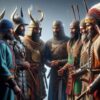Strategic Supremacy: Dominating the Battlefield in War Games
In the competitive realm of war games, achieving strategic supremacy is the ultimate goal for commanders seeking victory on the battlefield. “Strategic Supremacy: Dominating the Battlefield in War Games” serves as a comprehensive guide for players aiming to master the art of strategy, tactics, and leadership in virtual conflicts. From formulating grand strategies and executing decisive maneuvers to outwitting opponents and seizing control of the battlefield, this guide offers invaluable insights for commanders aspiring to assert their dominance in the digital theater of war.

Part 1: The Foundations of Strategy
Understanding Strategy
Strategy is the cornerstone of success in war games, guiding commanders in the formulation of long-term objectives, plans, and tactics to achieve victory on the battlefield. Commanders must understand the principles of strategy, such as the importance of setting clear goals, assessing enemy capabilities, and adapting their plans to changing circumstances. By mastering the fundamentals of strategy, commanders can develop comprehensive plans that outmaneuver opponents and secure victory.
The Art of Planning
Planning is essential for translating strategic objectives into actionable plans and tactics that achieve desired outcomes on the battlefield. Commanders must develop detailed plans that account for factors such as terrain, weather, enemy dispositions, and logistical considerations. Effective planning allows commanders to anticipate challenges, exploit opportunities, and synchronize their forces to achieve decisive results in combat.
Executing Maneuvers
Executing maneuvers is the essence of tactical warfare, as commanders seek to outmaneuver, outflank, and outsmart their opponents to gain the upper hand in combat. Commanders must deploy their forces strategically, coordinate their movements, and employ a variety of tactics, such as ambushes, feints, and encirclements, to gain a tactical advantage and achieve decisive victories on the battlefield.
Part 2: Command and Leadership
Effective Leadership
Effective leadership is essential for inspiring confidence, unity, and discipline among troops, empowering them to perform their duties with courage and commitment on the battlefield. Commanders must lead by example, demonstrating courage, integrity, and decisiveness in the face of adversity. By fostering a culture of excellence and accountability, commanders can inspire their troops to achieve extraordinary feats and overcome even the most daunting challenges in combat.
Decision-Making Under Pressure
Decision-making under pressure is a hallmark of leadership in war games, as commanders must make tough choices and trade-offs in high-stakes situations with limited time and information. Commanders must analyze the situation, assess the risks and benefits of different options, and make decisions that advance their strategic objectives and ensure the welfare of their troops. By making timely and informed decisions under pressure, commanders can steer their forces to victory and shape the outcome of battles.
Adaptability and Innovation
Adaptability and innovation are key attributes for commanders seeking to maintain the initiative and outmaneuver opponents on the battlefield. Commanders must be willing to adapt their strategies and tactics to changing circumstances, leveraging their creativity and resourcefulness to overcome obstacles and exploit opportunities. By embracing innovation and fostering a culture of adaptive thinking, commanders can stay ahead of their adversaries and achieve strategic supremacy in war games.
Part 3: Intelligence and Reconnaissance
Gathering Intelligence
Gathering intelligence is essential for commanders to gain insights into enemy intentions, capabilities, and movements on the battlefield. Commanders must deploy reconnaissance assets, surveillance technologies, and human intelligence sources to collect information through espionage, reconnaissance, and surveillance missions. By gathering timely and accurate intelligence, commanders can make informed decisions and devise strategies that outmaneuver and outsmart their opponents.
Analyzing Intelligence
Analyzing intelligence requires commanders to sift through vast amounts of data to identify relevant information and discern patterns and trends. Commanders must employ critical thinking and analytical skills to assess the reliability and significance of intelligence reports, separating fact from fiction and identifying potential threats or opportunities. Sound intelligence analysis enables commanders to make informed decisions and formulate effective plans based on accurate assessments of the battlefield environment.
Disseminating Intelligence
Disseminating intelligence effectively is crucial for ensuring that relevant information reaches the right people in a timely manner. Commanders must establish efficient communication channels and dissemination procedures to share intelligence with subordinate leaders and units. By disseminating actionable intelligence to troops on the ground, commanders empower them to make informed decisions and adapt their tactics to changing battlefield conditions.


